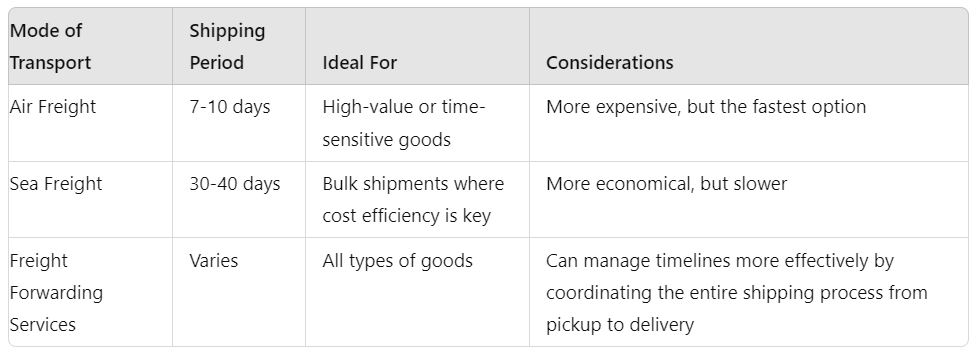
Navigating the world of international shipping can be a complex task, especially when sending goods from Australia to Argentina. To streamline your logistics operations and ensure smooth transactions, understanding the intricacies of customs regulations, shipping periods, and potential surcharges is crucial. This comprehensive guide will provide valuable insights tailored for freight forwarding companies, logistics providers, importers, exporters, customs brokers, manufacturers, producers, e-commerce businesses, and industry-related logistics vendors.
Understanding Customs Regulations in Argentina
Navigating customs regulations is often the most challenging aspect of international shipping. In Argentina, customs regulations are stringent, and non-compliance can lead to delays or fines.
- Documentation Requirements: Ensure you have all the necessary documentation, including commercial invoices, packing lists, and certificates of origin. These documents must be accurate and complete to avoid any hold-ups.
- Import Duties and Taxes: Be ready to incur import duties and taxes. These are calculated based on the value of the goods being shipped, including freight and insurance costs.
- Customs Brokers: Employing a customs broker can be beneficial. They are experts in navigating the complexities of customs regulations and can help expedite the clearance process.
Shipping Periods from Australia to Argentina
 Understanding shipping periods is crucial for planning and managing customer expectations. Shipping times can vary greatly based on the mode of transport.
Understanding shipping periods is crucial for planning and managing customer expectations. Shipping times can vary greatly based on the mode of transport.
- Air Freight: Typically, air freight from Australia to Argentina takes about 7-10 days. While more expensive, it is the fastest option and ideal for high-value or time-sensitive goods.
- Sea Freight: Sea freight is more economical but slower, usually taking 30-40 days. It is suitable for bulk shipments where cost efficiency is more critical than speed.
- Freight Forwarding Services: Utilizing a reliable freight forwarding service can help manage these timelines more effectively. They can coordinate the entire shipping process, from pickup to delivery, ensuring a smoother experience.
VAT
Value Added Tax (VAT) can significantly impact the cost of shipping, so it’s essential to understand how it applies.
- VAT Rates: In Argentina, the standard VAT rate is 21%. However, certain goods may be subject to reduced rates or exemptions.
- VAT on Imports: Importers must pay VAT on goods brought into Argentina. This is calculated based on the customs value of the goods, including shipping and insurance costs.
- Reclaiming VAT: In some cases, businesses can reclaim VAT paid on imports as input tax. Consult with a tax advisor to understand if this applies to your shipments.
Remote Area Surcharge (if applicable)
Shipping to remote areas can incur additional costs known as remote area surcharges.
- Identification of Remote Areas: Carriers have specific criteria for defining remote areas. Check with your carrier to identify if your destination falls within these criteria.
- Cost Implications: Remote area surcharges can add a significant cost to your shipping budget. It’s important to factor these into your overall costs.
- Mitigating Costs: Consider consolidating shipments or using alternative delivery methods to reduce the impact of these surcharges.
Restrictions
Knowing the restrictions on shipping certain goods to Argentina is essential to avoid legal issues and delays.
- Prohibited Items: Argentina has a list of prohibited items, including certain chemicals, weapons, and hazardous materials. Ensure none of your shipments contain these items.
- Restricted Items: Some items are restricted and require special permits, such as pharmaceuticals, food products, and plants. Obtaining the necessary permits in advance can prevent delays.
- Inspection Requirements: Be aware that certain goods may be subject to inspection upon arrival. This can include food products, live animals, and medical supplies.
Frequently Asked Questions (FAQ)
What documents are needed for customs clearance in Argentina?
You will require a commercial invoice, a packing list, and a certificate of origin. Additionally, a bill of lading or airway bill is required, depending on the mode of transport.
How are import duties calculated?
Import duties are calculated based on the customs value of the goods, which includes the cost of the goods, shipping fees, and insurance costs.
Can I ship chemicals to Argentina?
Shipping chemicals may require special permits and must comply with Argentina’s regulations on hazardous materials. It’s best to consult with a customs broker for guidance.
What are the typical shipping times for air and sea freight?
Air freight usually takes 7-10 days, while sea freight can take 30-40 days, depending on the specific ports and any potential delays.
Are there specific carriers recommended for shipping to Argentina?
Choosing a carrier with experience in shipping to Argentina is recommended. Companies like DHL, FedEx, and UPS offer reliable services and have experience with the local customs regulations.
Can businesses reclaim VAT on imports?
In some cases, businesses can reclaim VAT paid on imports as input tax. It’s advisable to consult with a tax advisor to understand the specific regulations and reclaim process.
Conclusion
Shipping from Australia to Argentina involves navigating a complex landscape of customs regulations, shipping periods, VAT implications, and potential surcharges. By understanding these key aspects and planning accordingly, you can ensure a smoother and more efficient shipping process.
For logistics providers, importers, exporters, and other industry professionals, staying informed and proactive is crucial. Consider employing customs brokers, utilizing reliable freight forwarding services, and leveraging expert advice to streamline your operations.
Ready to simplify your shipping process? Explore our resources and services to make your international shipping experience seamless and hassle-free. Reach out to us today for personalized assistance and start optimizing your logistics operations.










